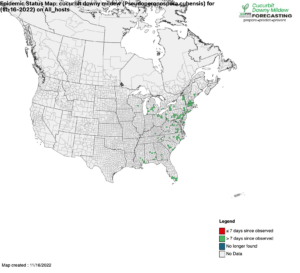 The The Cucurbit Downy Mildew Forecast website published their final forecast and epidemic update for the 2022 growing season on October 28, 2022. The final confirmed report of Cucurbit Downy mildew in the 2022 growing season occured on October 10, 2022 in York County, PA on butternut squash.
The The Cucurbit Downy Mildew Forecast website published their final forecast and epidemic update for the 2022 growing season on October 28, 2022. The final confirmed report of Cucurbit Downy mildew in the 2022 growing season occured on October 10, 2022 in York County, PA on butternut squash.
